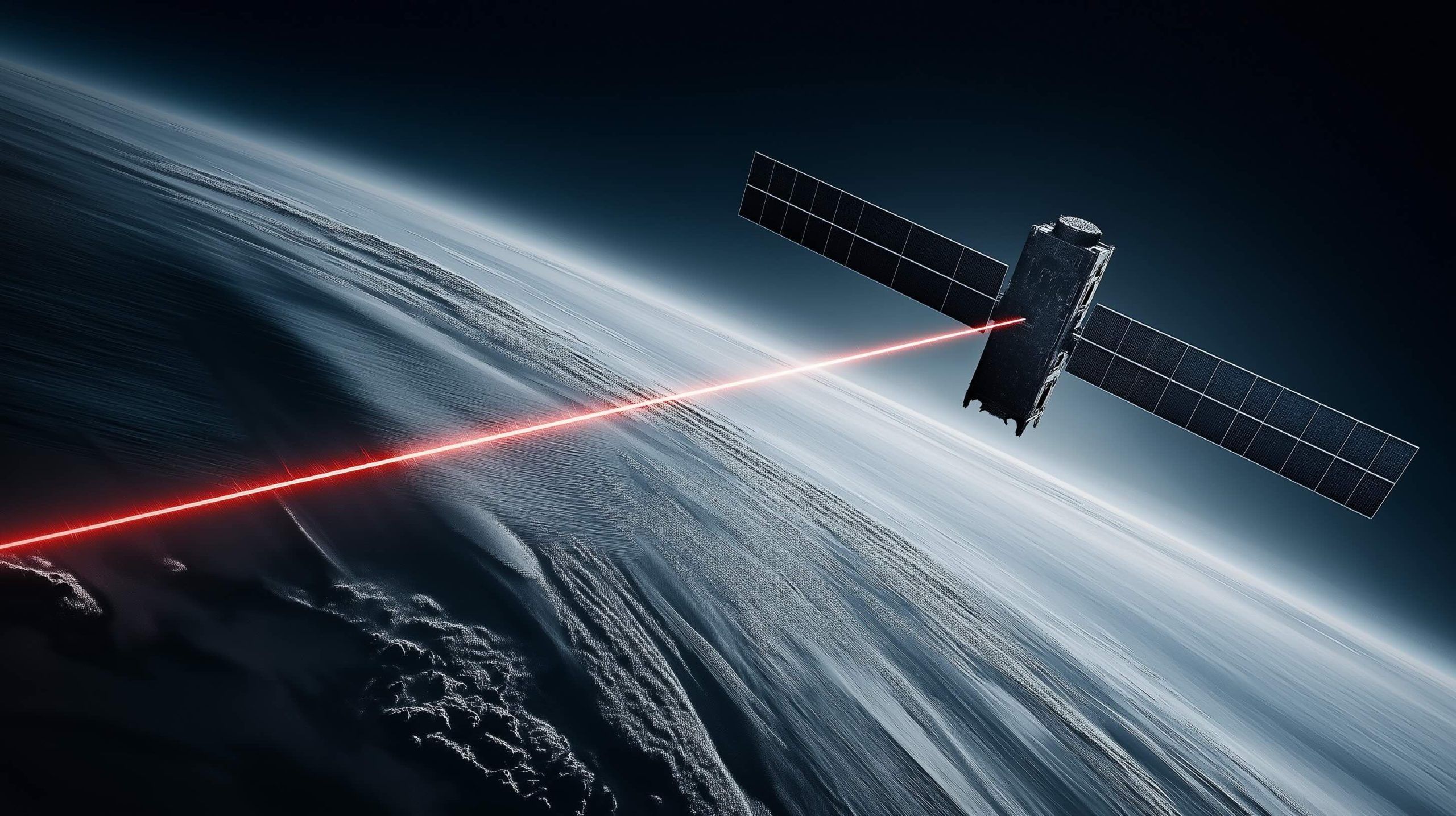- On June 17, 2025, a team led by Prof. Wu Jian (Peking University of Posts & Telecommunications) and Dr. Liu Chao (Chinese Academy of Sciences) achieved a 1 Gbps downlink from a geostationary satellite using a 2-watt optical laser.
- The GEO satellite was parked about 36,705 km above Earth and beamed data to a ground station in southwest China.
- The ground receiver used an 1.8-meter telescope at the Lijiang Observatory with advanced optics to capture the laser signal.
- The experiment delivered 1 Gbps downlink, five times faster than SpaceX Starlink’s typical 50–200 Mbps consumer speeds (bursts to 300–500 Mbps under ideal conditions).
- Researchers described the breakthrough as an AO-MDR synergy, combining Adaptive Optics and Mode-Diversity Reception to counter atmospheric turbulence.
- Adaptive Optics in the setup used a 357-micro-mirror array inside the 1.8-meter telescope to pre-undistort the wavefront in real time.
- Mode-Diversity Reception split the beam into eight spatial modes, with a multi-plane light converter selecting the best three channels every millisecond for data transmission.
- Data traversed the space-ground path of roughly 22,000 miles in under five seconds, demonstrated across multiple high-speed bursts with minimal errors.
- Compared with Starlink’s LEO, which sits at about 550 km altitude and offers ≈20–40 ms one-way latency, the GEO laser adds ~120–130 ms one-way latency, yielding 500+ ms end-to-end with light-travel delay.
- China’s broader space internet strategy includes the Guowang mega-constellation planned at 13,000–43,000 LEO satellites and SpaceSail (Qianfan) targets of 648 satellites initially and 15,000 by 2030.
Imagine beaming a high-definition movie across the globe in less than five seconds using a laser as weak as a night-light. This seemingly sci-fi scenario just became reality: from a geostationary orbit 36,000 km above Earth, a Chinese satellite used a mere 2-watt laser to transmit data to the ground at 1 gigabit per second (Gbps) – roughly five times faster than Elon Musk’s Starlink network typically delivers [1]. This record-breaking demonstration in June 2025 leapfrogs current satellite internet speeds and showcases a bold new direction for space-based communications. Below, we delve into the technical triumph, how it stacks up against Starlink, and what it means for the future of the global space internet.
China’s 1 Gbps Laser Link from GEO: What Happened?
A Historic Feat: On June 17, 2025, a team of Chinese scientists led by Prof. Wu Jian (Peking University of Posts & Telecommunications) and Dr. Liu Chao (Chinese Academy of Sciences) achieved a 1 Gbps downlink from an unnamed geostationary (GEO) satellite using an optical laser communication system [2] [3]. The satellite – “parked” about 36,705 km above Earth – beamed data to a ground station in southwest China. Remarkably, the laser transmitter was only 2 watts, about as dim as a candle flame [4]. By contrast, SpaceX’s Starlink satellites orbit much closer (~550 km altitude) and deliver download speeds on the order of 100–200 megabits per second to users [5]. Achieving gigabit rates from 60× farther away is a major breakthrough in itself.
Surpassing Starlink’s Speed: Starlink’s consumer terminals typically see 100–300 Mbps downlinks (peaking around ~500 Mbps under ideal conditions) [6]. China’s new laser link hit 1,000 Mbps, handily outpacing Starlink’s throughput even though the signal traveled a vastly longer distance [7]. In other words, the Chinese experiment delivered 5× the data rate of Starlink using a fraction of the power, albeit from a single experimental link [8]. “It’s groundbreaking to punch through atmospheric turbulence at gigabit rates with essentially a candle-power laser,” Wu Jian explained, highlighting the significance of the achievement [9]. The accomplishment was published in a peer-reviewed Chinese optics journal in June, indicating it has undergone scientific scrutiny [10].
Beating Atmospheric Odds: High-speed laser downlinks from space face a notorious enemy: atmospheric turbulence. Tiny fluctuations in air (from temperature, wind, etc.) scatter and distort laser beams, causing the signal to arrive faint and blurry at the telescope on the ground [11]. Past attempts around the world could not sustain high data rates from orbit under strong turbulence; even adaptive optics alone wasn’t enough to fully clean up the signal [12]. What makes the Chinese demo so special is that it overcame this turbulence problem in real-world conditions, sustaining 1 Gbps over a long distance with minimal power.
The Test Setup: The experiment took place at the Lijiang Observatory in Yunnan, southwest China [13]. On the ground, the team deployed a 1.8-meter telescope equipped with advanced optics. The GEO satellite’s downlink laser was pointed to this ground station and maintained for a burst of high-speed data transmission. According to the researchers, data crossed the space-to-ground path (roughly 22,000 miles) in under five seconds for a full gigabit payload [14] – a dramatic illustration of its capacity (imagine transmitting an HD movie nearly instantaneously). Crucially, this wasn’t just a one-off blink: the system was tested through multiple runs, consistently achieving the high data rate without significant errors [15].
How Did They Do It? The “AO-MDR” Synergy Explained
Breaking the 1 Gbps barrier from GEO required a “groundbreaking” method that merges two advanced techniques: Adaptive Optics (AO) and Mode-Diversity Reception (MDR) [16] [17]. The Chinese team refers to this hybrid approach as “AO-MDR synergy.” Here’s how it works and why it matters:
- Adaptive Optics (AO): Using a deformable mirror system, the ground telescope actively reshapes the incoming laser beam’s wavefront in real time [18] [19]. In this experiment, an array of 357 tiny micro-mirrors inside the 1.8 m telescope made minute adjustments thousands of times per second to counteract the blurring effect of turbulence [20]. By preemptively “undistorting” the light, AO sharpens the beam’s focus when it arrives at the detector. This cancels out most of the atmospheric blur before the data is read [21] [22].
- Mode-Diversity Reception (MDR): After AO correction, the incoming light is fed into a multimode fiber and split into multiple parallel channels (spatial modes). In this case, a multi-plane light converter separated the beam into 8 distinct spatial modes [23] [24]. Each mode can carry the signal, albeit some will be degraded by turbulence more than others. The system’s software monitors all the channels in real time and picks the best 3 channels every millisecond to use for data transmission [25] [26]. This way, even if some modes fade or drop bits, others remain clear – effectively “diversifying” the pathways the laser data can take.
- Real-Time Path Selection: A custom path-picking algorithm orchestrates the above, constantly selecting the strongest, cleanest signals among the 8 channels on the fly [27]. By always routing the data through the least-disturbed modes, the system maintains a high effective data rate with minimal errors. In essence, AO gives the laser beam a tighter focus, while MDR scoops up the stray bits that would otherwise be lost when the beam gets distorted [28] [29]. Together, they turned what would normally be an extremely weak, fuzzy spot of light (after crossing 36,000 km of turbulent atmosphere) into a robust gigabit data stream.
Dramatic Reliability Boost: The results of combining AO + MDR speak volumes. The researchers reported that the probability of receiving a usable signal jumped from roughly 72% to over 91% when using the synergistic method [30]. In other words, nearly all of the transmitted data made it through intact, despite the low power and atmospheric interference. By reducing transmission errors and dropouts, the team achieved a smooth high-bandwidth link. For high-value data (imagine large earth observation files or real-time video feeds), this reliability is crucial – fewer errors mean fewer retransmissions and a far more efficient channel [31] [32]. As one report put it, the AO-MDR technique “sharpens” the laser beam and then catches what turbulence would otherwise spill, allowing a dim laser to deliver GEO-class bandwidth reliably [33] [34].
Prior Experiments: It’s worth noting that this isn’t China’s first foray into laser communications, but it is their most impressive to date from GEO. In 2020, China’s Shijian-20 technology demonstration satellite (also in geostationary orbit) achieved a then-record 10 Gbps laser downlink to Earth [35]. However, that feat (10× the data rate of the new test) likely required significantly more laser power or ideal conditions – the details on Shijian-20’s power levels were not disclosed [36]. The new 1 Gbps experiment, by contrast, was explicitly about doing more with less – maintaining high speed with a tiny 2 W laser by using clever optics. This showcases a different kind of advancement: not raw bitrate, but efficient, turbulence-hardened communication. As noted in one analysis, the novelty here is achieving high power-per-bit efficiency from GEO rather than setting an absolute speed record [37]. (In fact, other recent tests have higher headline speeds – for example, SpaceX’s Starlink satellites use laser crosslinks up to ~100 Gbps in space, and a Chinese startup Laser Starcom announced a 400 Gbps inter-satellite laser link in LEO in 2025 [38] [39]. Those dwarf 1 Gbps, but they operate in vacuum between satellites or at much shorter range, not through 36,000 km of atmosphere to the ground.)
Starlink vs. Laser Comm: How Do They Compare?
China’s achievement invites inevitable comparisons to SpaceX’s Starlink, currently the world’s largest satellite internet system. However, the two are fundamentally different approaches – each with pros and cons:
- Throughput: A single Chinese laser link hit 1 Gbps, whereas a single Starlink user terminal typically sees anywhere from 50 to 200 Mbps under normal conditions [40]. Some Starlink users can burst up to ~300–500 Mbps in ideal cases, but gigabit speeds are not the norm for the consumer service [41]. Starlink’s total network capacity is spread across thousands of satellites and user beams, whereas the Chinese demo concentrated high bandwidth in one link. In practical terms, the Chinese GEO laser could beam a multi-gigabyte file in seconds [42], a task that would take a Starlink connection several minutes. However, Starlink can serve many users simultaneously across its constellation; the Chinese experiment was a point-to-point test.
- Distance and Latency: Starlink operates in Low Earth Orbit (LEO) about 550 km up, yielding low latency (≈20–40 ms one-way, similar to fiber broadband on Earth) for activities like video calls and online gaming. The Chinese laser link came from Geostationary Orbit, ~36,000 km up – which inherently introduces about 120–130 ms of one-way latency (over 0.24 seconds round-trip just in light travel time). For an end-to-end internet connection, GEO latency is often 500+ ms total, noticeable in interactive applications. No optical technology can overcome the speed-of-light delay from GEO; so in latency-sensitive use cases, Starlink’s lower altitude retains an advantage [43]. In short, Starlink trades raw speed for responsiveness, whereas the GEO laser link favors bandwidth over ping time.
- Coverage and Constellation Size: A single GEO satellite hovers over a fixed spot and can cover roughly one-third of the Earth’s surface with its communications footprint. Starlink, by contrast, uses a mega-constellation of thousands of LEO satellites to blanket the globe. As of early 2025, Starlink has about 4,000–7,000 satellites in orbit (on its way to 42,000 planned) to provide continuous coverage [44]. China’s strategy might leverage a few high-capacity GEO lasers plus regional low-orbit nodes (as described later) rather than sheer numbers. The Chinese experiment’s unnamed satellite was described as “secret” and stationary [45], suggesting it could be a purpose-built test satellite. One GEO satellite can’t provide global coverage (only the region beneath it), but three evenly spaced GEO sats can cover most of the world (except polar areas). Bottom line: Starlink’s approach = many satellites in LEO moving overhead; China demonstrated an alternative = far fewer satellites in higher orbits with powerful links.
- Reliability – Weather and Atmosphere: This is a critical difference. Starlink uses radio-frequency (RF) microwaves (Ku/Ka band) to reach user terminals. RF signals can penetrate clouds, rain, and dust fairly well (though heavy rain or obstruction can degrade Starlink, it still works in most weather). Laser links, however, do not work through clouds or fog – a thick cloud can completely block the infrared laser beam. The Chinese experiment was conducted in clear skies at a high-altitude observatory known for good viewing conditions [46]. For an operational system, relying on lasers means you need strategies for bad weather: either multiple widely spaced ground stations (so at least one is clear at any time), adaptive routing (switching to RF as backup), or satellite-to-satellite relays to bypass local weather. This remains a major challenge for laser comm: great when clear, useless in heavy clouds. Starlink’s RF links have a clear uptime advantage in diverse weather. On the other hand, lasers don’t suffer radio interference or require spectrum licenses – an advantage in crowded RF environments.
- Terminal Hardware: The Chinese ground terminal in this demo was essentially an astronomical observatory – a 1.8 m telescope with sophisticated optics [47] [48]. This is not something you could install on your rooftop easily! By contrast, Starlink dishes are compact ~0.5 m phased-array antennas that consumers can mount on a roof or take in an RV. For laser internet to reach consumers directly, significant miniaturization is needed so that optical terminals can be small, low-cost, and safely eye-safe. Chinese scientists did not discuss deploying 1.8 m laser receivers to every home (clearly impractical); rather, such a laser link would likely act as a feeder to an internet backbone, connecting major nodes. It’s possible to imagine a hybrid network: a few large optical ground stations handling high-volume links to satellites, then distributing internet to users via WiFi, 5G, or even LEO radio satellites. In fact, industry analysts note that a gigabit-class GEO laser feeder could let traditional satellite operators feed local networks (or small LEO clusters) on the ground, potentially undercutting the need for massive constellations in terms of cost per subscriber [49]. But until optical terminals shrink and weather-proofing solutions emerge, Starlink’s approachable hardware and all-weather usability give it a practical edge for direct-to-consumer service [50].
- Security and Interference: Laser communications are inherently harder to eavesdrop on or jam. A laser beam is narrow and point-to-point; one would have to physically get in its path to intercept it, which is extremely difficult at high altitude (and the beam footprint at Earth was only a few hundred meters wide in this demo [51]). Radio beams, by contrast, spread wider and can be detected or jammed from afar if one has the right equipment. This means optical links offer higher security and lower probability of interception, a fact not lost on military planners [52]. (Starlink’s signals are encrypted, but the RF nature still makes them detectable.) However, lasers introduce new vulnerabilities: the beam can be disrupted by physical obscurants (smoke, clouds) or potentially dazzled by other lasers. There’s also the scenario of intentional dazzling: an adversary could conceivably target a sensitive optical receiver with a blinding laser. On balance, for covert or resilient communications, many see laser links as the next step – an “arms race” is quietly under way to develop these technologies for both civil and military uses [53].
In summary, comparing the Chinese GEO laser link to Starlink is a bit of an apples vs. oranges situation. Starlink is a proven, widely-deployed LEO radio constellation optimized for broad coverage and low latency, while the Chinese demonstration was a proof-of-concept of ultra-high-throughput optical communication from a single high orbit satellite. The Chinese system won’t replace Starlink overnight – but it highlights a different path: one where fewer satellites could potentially deliver extremely high bandwidth using lasers, if their limitations can be managed. As one expert observed, Starlink itself is already adopting laser inter-satellite links, and Chinese firms are testing hundreds-of-Gbps links in space, so the real breakthrough in this GEO demo is the efficient handling of turbulence (i.e. engineering, not just raw speed) [54].
China’s Space Communication Ambitions and Strategy
This laser leap is not an isolated stunt – it fits into a broader Chinese strategy for space-based internet and communications. In recent years, China has been pouring resources into satellite internet technologies to rival the likes of Starlink and Amazon’s upcoming Kuiper constellation. Here’s the bigger picture:
- Megaconstellation Plans: China has announced several LEO satellite constellations. The biggest is a government-backed project often dubbed Guowang or integrated under the state-run China Satellite Network Group. Reports indicate China could deploy 13,000 up to 43,000 satellites in LEO in the coming decades [55] – a number on par with or even exceeding Starlink’s plans. For example, a Shanghai-based venture called “SpaceSail” (Qianfan) aims for 648 satellites initially and 15,000 by 2030 [56]. The goal, as one analyst put it, “is to occupy as many orbital slots as possible” – essentially staking a claim in low orbit before others do [57] [58]. This is partly a competitive move: Starlink’s rapid deployment spurred China to not be left behind in what some call the new space race for the “orbital real estate” of internet satellites.
- Geopolitical Motivation: Beyond commercial profits, China views a global satellite internet as a strategic asset. A domestic constellation would secure China’s own communications (so it’s not dependent on foreign-owned networks like Starlink), and it can be offered to other countries as part of China’s influence. Western officials worry that if Chinese satellite internet services proliferate in the developing world, Beijing could extend its internet governance model (including censorship or surveillance capabilities) via those networks [59]. It’s a high-tech extension of the Belt and Road Initiative, providing digital infrastructure. This competitive backdrop explains why China is racing to develop advanced tech (like the laser link) that could give it an edge or a unique selling point in the global market for satellite broadband.
- Investments in Tech and Launch: China is investing heavily in the full ecosystem – satellites, rockets, ground stations, and key technologies like laser communications and high-throughput antennas. Dozens of Chinese companies (many state-affiliated) are working on satellite internet hardware. In 2023, one firm launched 41 satellites in a single batch to expand a remote-sensing constellation, with some carrying laser communication payloads to test intersatellite and space-to-ground links [60]. The government is also funding next-gen reusable rockets and mega-launchers that can deploy batches of satellites efficiently [61]. All of this underlines a national priority: build a space internet to compete with Starlink and ensure China isn’t left out of a future dominated by orbiting networks.
- Role of Optical Communications: The pursuit of laser comm is part of breaking bottlenecks in data downlink capacity. Traditional radio frequencies have bandwidth limits – there’s only so much spectrum available, and frequency licenses can be a bureaucratic hurdle. Optical links offer far higher bandwidth (thanks to the high frequency of laser light) and aren’t regulated by the same spectrum allocations [62] [63]. Chinese satellites, especially those doing earth observation, generate tons of data (imaging, video, etc.). Getting all that data down to Earth quickly is a challenge. As SpaceNews reported, Chinese firms see high-speed laser downlinks as a way to “break bottlenecks” in getting data from space to ground [64] [65]. Last year (2023), a Chinese commercial satellite demonstrated 10 Gbps downlink via laser (from a LEO imaging sat), which was 10× faster than previous radio downlinks [66]. The recent 1 Gbps GEO test and even the 10 Gbps Shijian-20 test in 2020 [67] are aligned with this trend: proving that optical links can dramatically boost capacity for future networks. In addition, China’s new LEO satellites are being built with laser inter-satellite link capabilities (much like Starlink’s newer models), so that data can be routed in space from satellite to satellite at high rates [68]. The eventual vision is a high-speed optical mesh network in orbit, with minimal reliance on ground relay stations.
- Dual-Use Considerations: The Chinese military and space authorities often emphasize the dual-use nature of space tech – meaning it serves both civilian and military purposes. Encrypted laser communications are attractive for the People’s Liberation Army (PLA) for secure links between satellites, drones, aircraft, and ground bases that are extremely hard for adversaries to intercept or jam [69]. Chinese military researchers have explicitly discussed optical communication as a route to “low probability of interception” networks [70]. Furthermore, the know-how from high-powered optical links could feed into directed-energy systems. In fact, U.S. defense officials note that China has already fielded ground-based lasers for dazzling or damaging satellites (e.g. blinding imaging sensors), and is on track to develop more powerful versions that could physically damage satellite structures by the late 2020s [71]. In this context, a seemingly benign communication laser test can also demonstrate technologies relevant to precision pointing and beam control – which are also crucial for laser weapons. The test used precision tracking to keep the laser locked on target over 36k km, reportedly within 5 microradians of accuracy [72]. Such precision in beam steering is also what you’d need to aim a high-power laser weapon at a satellite. The overlap in expertise is evident, which is why advancements like the 1 Gbps link are watched closely by strategic analysts. It’s “both a telecom milestone and a strategic warning shot,” as one space technology review put it [73].
Implications: A New Chapter for Space Internet
China’s record-setting laser link hints at what the post-Starlink future of space-based internet might look like. The implications span technology, business, and geopolitics:
1. Ultra-Fast Space Backbone: One immediate application of 1 Gbps+ laser downlinks is as a “space backbone” – high-speed trunks connecting satellites to the terrestrial internet. Instead of each satellite sending data down via comparatively slow RF links to numerous ground stations, a few optical ground stations could handle huge flows of data. For example, a GEO satellite with a gigabit laser link could funnel internet data to a region, and then distribute it to users via local means. This could make satellite internet more scalable. SpaceX’s Starlink, for all its strengths, is constrained by how much bandwidth each satellite can hand off to ground users. Laser links could dramatically increase that cap, enabling services like 4K video streaming, large file transfers, and real-time VR from space with ease [74] [75]. Imagine live broadcasting from anywhere via satellite at fiber-optic speeds – that becomes more feasible with such tech.
2. Complementing vs. Replacing Radio: Will lasers replace radio in space comms? Not entirely, at least not soon. Rather, we’re likely to see a hybrid model. Lasers will handle the ultra-high-bandwidth routes (satellite-to-satellite crosslinks and satellite-to-“big” ground station downlinks), while radio will remain in use for mobile users, cloudy areas, and broad coverage. Even Starlink is a hybrid: it uses laser crosslinks in orbit now, but still radios to user terminals. Similarly, future Chinese constellations might use optical links for intersatellite routing and for feeding regional hubs, then use traditional radio beams (or even 5G/6G integration) to serve individual devices. Over time, as optical tech matures, we may see more direct laser-to-user attempts – perhaps aircraft or high-altitude drone relays with optical links to space and 5G to the ground, etc. The recent demo is a proof of concept that extremely high-throughput links to ground are possible. The next steps would be to miniaturize the tech and build a network around it.
3. Lower Cost Constellations?: One reason Starlink and others go for thousands of satellites is to increase capacity and reduce latency by being closer to users. But a counter-approach could be: use a few high-throughput GEO or MEO satellites with optical links that can service many users via relay. This is closer to the traditional satellite internet model (ViaSat, etc.) but turbocharged with lasers. If China or others can achieve multi-Gbps per satellite and steerable optical links, they might cover large areas with far fewer satellites than Starlink – potentially a cheaper deployment if they can overcome the tech hurdles. This could lower the barrier to entry for countries or companies wanting their own satellite internet slice, without needing SpaceX-level launch capabilities. For instance, a handful of satellites with optical downlinks to a dozen ground nodes could serve a continent’s backhaul needs, and local ISPs or cellular networks distribute to users. This kind of hybrid architecture might emerge as an alternative in regions that don’t get Starlink service or prefer an independent system. In fact, some analysts suggest pairing a big GEO laser satellite with a “cache” of small LEO satellites (or even high-altitude platforms) could deliver broadband with much less hardware in orbit, thus lowering cost per user [76]. The Chinese demo gives credibility to that idea.
4. Geopolitical and Market Impact: Strategically, this demonstration is a signal that China is closing the tech gap in space communications. Starlink, pioneered by a U.S. company, currently dominates in deployment and real-world users (over 1.5 million subscribers globally). China’s response appears to be innovation as well as scale – not just trying to launch thousands of sats, but also leapfrogging in capability (such as laser comm, higher-frequency 6G experiments, quantum satellites, etc.). This could heat up competition in the satellite internet market. We might soon see offerings that tout “laser-powered” high-speed connections as a selling point. Countries wary of relying on Starlink (due to it being U.S.-operated) might find a Chinese alternative attractive, especially if it promises high performance. On the other hand, SpaceX and other Western companies won’t stand still – we can expect them to integrate similar advances. In the end, end-users worldwide could benefit from faster, more ubiquitous internet from the skies, coming from multiple providers.
5. Military and Security Dimensions: The overlap of communication and military use can’t be ignored. Secure laser links might become standard for militaries (to connect surveillance satellites, drones, fighter jets, etc.). If one side demonstrates a capability (e.g. China’s gigabit laser comm), others will accelerate their programs. The U.S. Space Force and NASA have been testing laser communications too – for example, NASA’s LCRD (Laser Communications Relay Demonstration), launched in 2021 to GEO, is designed to experiment with optical data relays around 1.2 Gbps. And NASA’s recent TBIRD experiment achieved an astounding 200 Gbps downlink from a small LEO satellite in 2022 [77]. The European Space Agency has also used laser links (the European Data Relay System links satellites via laser at ~1.8 Gbps). These developments all feed into a new ecosystem of space communication that is far more capable than the older radio-based systems. But they also introduce new strategic considerations: satellite networks with lasers will be harder to monitor or disable via conventional electronic warfare. This could upend the current paradigm of space control and anti-satellite measures, forcing nations to consider new countermeasures (e.g. deploying optical sensors, or as U.S. officials hinted, adding protective features like reflective coating or maneuver capabilities to satellites as lasers proliferate [78]).
6. Challenges Ahead: For all the promise, some healthy skepticism is warranted. The Chinese 1 Gbps test, while impressive, was still a controlled experiment. It was one downlink, likely of short duration, under clear conditions. We haven’t seen how it performs 24/7 through seasons, weather, and operational load. As critics point out, “single-sat test – no continuous throughput data over months yet” [79]. Also, the current solution involves large, costly equipment (1.8 m telescopes, etc.) [80]. Engineering that down to affordable user terminals or even transportable stations will be a big task. Clouds remain a stubborn problem – no advance in optics can prevent a thick cloud bank from blocking a laser (though alternate strategies can route around, it adds complexity) [81]. And while a 2 W laser is eye-safe and not a weapon, as mentioned, scaling up power for even higher speeds might raise safety and regulatory issues (not to mention potential weaponization concerns) [82]. In short, there’s work to be done before “laser internet” is as common and reliable as today’s radio-based services.
Future Outlook: Toward a Laser-Powered Space Internet
The successful 1 Gbps GEO laser link marks the beginning of a new chapter. Going forward, we can expect:
- More Demonstrations: China and others will push this further. Experiments with higher power lasers and even higher data rates are likely. In fact, Chinese labs are already talking about kilowatt-class space lasers for communications and other purposes [83]. We might see a 10 Gbps or even 100 Gbps laser downlink from GEO in the next few years, especially if they pair these techniques with more power or advanced modulation. The record 100 Gbps satellite-to-ground test that China reportedly achieved in early 2025 [84] could be extended from short bursts to longer, more practical links. Every jump in bandwidth will enable new services (imagine streaming holographic content or massive real-time data feeds from satellites).
- Hybrid Networks: The boundary between “satellite internet” and terrestrial internet will blur. High-speed laser links from space could integrate with 6G networks on the ground, since 6G is expected to use high-frequency (even optical/THz) signals and satellite components. We may see constellations where GEO lasers feed LEO satellites, which then use both lasers and RF to reach end-users. Smart routing will send data over optical links when possible, and fail over to RF when clouds obstruct. Companies are already working on network orchestration that can handle this kind of switching. The result might be a global mesh of connectivity that is part optical, part radio, dynamically optimizing for throughput and latency.
- Starlink Evolution: SpaceX is unlikely to rest on its laurels. Elon Musk’s team could respond by upping Starlink’s capabilities – perhaps using optical feeder links for Starlink (e.g. connecting satellites to ground gateways via laser in clear-sky areas to offload the radio spectrum). There’s also talk of next-gen user terminals. In fact, Starlink has been testing ~1 Gbps speeds in limited scenarios and is developing a direct-to-cell service with lasers in space and cell towers on the ground. The competition may drive higher-bandwidth tiers of Starlink or new products (Starlink “Gigabit” service, perhaps using a larger dish or a laser receiver at the customer end, though that’s speculative). This Chinese achievement essentially throws down a gauntlet: space internet can be much faster – who will commercialize it first?
- International Norms and Security: As powerful lasers populate orbit (whether for comms or other uses), the international community will need to update space norms and regulations. Currently, radio frequencies are tightly coordinated by bodies like the ITU; laser communications have fewer international rules (they mainly need to avoid blinding aircraft or satellites unintentionally). We might see new agreements on laser safety, handling of interference (e.g. if two optical links cross paths), and especially on the weaponization issue. The United Nations has an Open-Ended Working Group on reducing space threats, which is likely to discuss where the line is between a “laser com uplink” and a potential “laser weapon” if power keeps scaling [85] [86]. Transparency measures or even bans on certain high-power applications could be proposed. At the same time, the militaries will be hardening their assets – e.g. the U.S. may add protective features to critical satellites knowing that China (and Russia, and others) are advancing in laser tech [87].
In conclusion, China’s 1 Gbps geo-laser link is a remarkable milestone that demonstrates the viability of laser communications at a scale and distance once thought impractical. It doesn’t render Starlink obsolete overnight – latency and deployment scale still favor the LEO approach – but it suggests future space internet systems might not need to follow Starlink’s template exactly. We could end up with a mix of architectures: some heavy on hundreds of low-flying satellites, others leveraging a few high-flying, high-bandwidth laser platforms. The “Laser Leapfrog” achieved by China is as much a technology statement as it is a practical experiment. It shows that with clever optics and engineering, even a weak beam of light from GEO can deliver fiber-like speeds to Earth [88] [89]. As every leap in space communication also carries strategic weight, this success will undoubtedly spur others to accelerate their own optical comm programs. The race for the post-Starlink space internet – faster, more secure, and more globally accessible – is officially on, with lasers now leading the charge.
Sources:
- South China Morning Post – Stephen Chen, “Chinese satellite achieves 5 times Starlink speed with 2-watt laser from 36,000km orbit” (17 Jun 2025) [90] [91]
- Times of India – Tech Desk, “Chinese researchers achieve internet 5 times faster than Starlink using 2-watt laser” (23 Jun 2025) [92] [93]
- Interesting Engineering – Mrigakshi Dixit, “China claims its high-orbit laser communication tops Starlink speed” (Jun 2025) [94] [95]
- SpaceNews – Andrew Jones, “China’s Changguang Satellite demonstrates space-to-ground laser links” (30 Jun 2023) [96] [97]
- Reuters – Bhattacharjee et al., “Chinese rivals to Musk’s Starlink accelerate race to dominate satellite internet” (24 Feb 2025) [98] [99]
- IEEE Spectrum – Andrew Jones, “China Makes High-Speed Laser Links in Orbit” (12 May 2025) [100] (400 Gbps inter-satellite test)
- Defense One – Audrey Decker, “How China is expanding its anti-satellite arsenal” (3 Apr 2025) [101] (laser weapons development)
- TS² Space Tech Blog – Marcin Frąckiewicz, “China’s ‘Night-Light’ Laser Satellite Leaves Starlink in the Dust – What It Means for the Future of Space Internet and Warfare” (23 Jun 2025) [102] [103] (analysis & expert commentary)
References
1. www.scmp.com, 2. timesofindia.indiatimes.com, 3. timesofindia.indiatimes.com, 4. www.scmp.com, 5. www.starlink.com, 6. ts2.tech, 7. ts2.tech, 8. www.scmp.com, 9. ts2.tech, 10. timesofindia.indiatimes.com, 11. www.scmp.com, 12. www.scmp.com, 13. interestingengineering.com, 14. www.scmp.com, 15. interestingengineering.com, 16. timesofindia.indiatimes.com, 17. timesofindia.indiatimes.com, 18. interestingengineering.com, 19. interestingengineering.com, 20. interestingengineering.com, 21. interestingengineering.com, 22. timesofindia.indiatimes.com, 23. interestingengineering.com, 24. timesofindia.indiatimes.com, 25. interestingengineering.com, 26. timesofindia.indiatimes.com, 27. interestingengineering.com, 28. ts2.tech, 29. ts2.tech, 30. timesofindia.indiatimes.com, 31. interestingengineering.com, 32. interestingengineering.com, 33. ts2.tech, 34. ts2.tech, 35. timesofindia.indiatimes.com, 36. timesofindia.indiatimes.com, 37. ts2.tech, 38. ts2.tech, 39. spectrum.ieee.org, 40. www.starlink.com, 41. ts2.tech, 42. www.scmp.com, 43. ts2.tech, 44. www.reuters.com, 45. www.scmp.com, 46. ts2.tech, 47. timesofindia.indiatimes.com, 48. timesofindia.indiatimes.com, 49. ts2.tech, 50. ts2.tech, 51. www.scmp.com, 52. ts2.tech, 53. ts2.tech, 54. ts2.tech, 55. www.reuters.com, 56. www.reuters.com, 57. www.reuters.com, 58. www.reuters.com, 59. www.reuters.com, 60. spacenews.com, 61. www.reuters.com, 62. interestingengineering.com, 63. interestingengineering.com, 64. spacenews.com, 65. spacenews.com, 66. spacenews.com, 67. timesofindia.indiatimes.com, 68. spacenews.com, 69. ts2.tech, 70. ts2.tech, 71. www.defenseone.com, 72. ts2.tech, 73. ts2.tech, 74. interestingengineering.com, 75. interestingengineering.com, 76. ts2.tech, 77. ntrs.nasa.gov, 78. ts2.tech, 79. ts2.tech, 80. ts2.tech, 81. ts2.tech, 82. ts2.tech, 83. ts2.tech, 84. interestingengineering.com, 85. ts2.tech, 86. ts2.tech, 87. ts2.tech, 88. www.scmp.com, 89. ts2.tech, 90. www.scmp.com, 91. www.scmp.com, 92. timesofindia.indiatimes.com, 93. timesofindia.indiatimes.com, 94. interestingengineering.com, 95. interestingengineering.com, 96. spacenews.com, 97. spacenews.com, 98. www.reuters.com, 99. www.reuters.com, 100. spectrum.ieee.org, 101. www.defenseone.com, 102. ts2.tech, 103. ts2.tech










